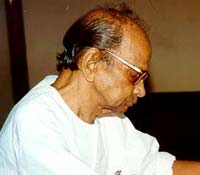
Odia is an Indo-Aryan classical language spoken in the Indian state of Odisha. It is the official language in Odisha, where native speakers make up 82% of the population, and it is also spoken in parts of West Bengal, Jharkhand, Andhra Pradesh and Chhattisgarh. Odia is one of the many official languages of India; it is the official language of Odisha and the second official language of Jharkhand.

Nandini Satpathy was an Indian politician and author. She was the Chief Minister of Odisha from June 1972 to December 1976.
Odisha is one of the 28 states of India, located on the eastern coast. It is surrounded by the states of West Bengal to the northeast, Jharkhand to the north, Chhattisgarh to the west and northwest, and Andhra Pradesh to the south and southwest. Odia is the official and most widely spoken language, spoken by 33.2 million according to the 2001 Census. The modern state of Odisha was established on 1 April 1936, as a province in British India, and consisted predominantly of Odia-speaking regions. April 1 is celebrated as Odisha Day.

The Odia cinema, colloquially known as Ollywood, is the Odia language Indian film industry, based in Bhubaneshwar and Cuttack in Odisha, India. The name Ollywood is a portmanteau of the words Odia and Hollywood.

Anubhav Mohanty is an Indian actor, politician, film producer, television personality and social activist who is known for his work majorly in Odia language films. Mohanty has also worked in Bengali films. Mohanty has a significant fan following especially in Odisha.

Sarat Pujari was an Indian actor, director and producer in Odia film industry (Ollywood). He was originally from Jhaduapada, Sambalpur.
Lalita is a 1949 Indian folklore Oriya film directed by Kalyan Gupta.

Bijay Mohanty was an Indian actor in Odia Cinema. He starred in the film Chilika Teerey, which was honored a National Film Award.

Swayamsiddha is a 2010 Odia film directed by Sudhanshu Sahu with a screenplay and dialogue by Dilip Choudhury, produced by Prabhat Ranjan Mallik, and starring Siddhanta Mahapatra and Yukta Inderlal Mookhey. The film focuses on the implications for the young mass adopting to Maoist insurgency and their sustained alienation from the mainstream as a result. Geo-strategic importance of changing the minds of young people adopting terrorism through love and affection. The film traces the crisis from social trauma to unfair state system encouraging Mao-Naxal insurgency in Odisha.
Suryamukhi is a 1963 Oriya film directed by Prafulla Sengupta.

Kebe Tame Naahan Kebe Mun Naahin is a 2012 Oriya film directed by Chakradhar Sahu starring Sabyasachi Mishra, Archita Sahu and Manoj Mishra. The film released on 17 February 2012.

Gopal Chhotray (1916–2003) was an Indian dramatist and playwright. He was born in Puranagarh village of Jagatsinghpur district in Bihar and Orissa Province, India.

Prafulla Kar was an Odia musician, singer, lyricist, writer and columnist. He was also famous for his Odissi Music recital. He received Padma Shri, the fourth highest civilian award by the Government of India in 2015 for his contribution in the field of arts.

Sabyasachi Mishra is an Indian actor known for his work in Odia Cinema. He is referred to as "Superstar of Ollywood". Pagala Premi was his first movie, for which he earned an Odisha State Film Awards for Best Actor. Sabyasachi got his second state award for Emiti Bi Prema Hue. He won the Filmfare Awards East as best actor for Mu Eka Tumara in 2013.

Mohan Sundar Deb Goswami was an Odissi musician, poet & composer, a Guru of traditional Rahasa or Rasa and film director in Odia-language films. Widely known for his efforts to keep alive the Rahasa or Rasa, a traditional theatrical form depicting the romance of Radha and Krishna, Gosain became iconic for his renditions of classical Odissi songs, including Odissi, Chhanda, Champu, Kirtana, Bhajana, Janana, etc. His renditions on gramophone records pressed under the label His Master's Voice and over All India Radio made him a household figure in Odisha. He had a major role in creating the first Odia film Sita Bibaha in the year 1936, himself directing, producing and acting in this film.
Manimala Devi was an Indian Odia film actress. Devi was born in the Bilibasi village of Cuttack, and stepped into the film world at the age of nine. She never went to school. In 1945 she started to act in the Annapurna theatre of Cuttack.

Akshay Kumar Parija is an Indian film maker known for his depictions of Odia culture and Odissi dance in his films. Originally a banker, he currently lives in Dubai.
Kanhu Charan Mohanty was an Indian Odia language novelist who wrote fifty-six novels in a career spanning over six decades from 1930 to 1985. He is considered "one of the most popular and celebrated novelists of Odisa". Mohanty was awarded the Sahitya Akademi Award in 1958 for his novel, Kaa, published in 1956, and was one of the fellows of the Sahitya Akademi. Mohanty died on 6 April 1994 at the age of 87.
Birakishore Das, popularly known as "Jatiya KabiBirakishore" was a poet, social activist and politician from Odisha. Best known for the editor of " Mo Desha" a monthly magazine.

Desaraja AdiguruSinghari Shyamasundar Kar was a renowned Odissi musician, Guru, singer, scholar and composer. Born to a sebayata (servitor) family of the Jagannatha Temple, he was groomed under veteran masters of the temple tradition and soon rose to be one of the towering Gurus of Odissi classical music in the 20th century. He was most known for his powerful voice and intricate style, his command over the Mardala as well as his contribution towards the academic institutionalization of Odissi music education. Most of the performers of Odissi music, Mardala and Odissi dance of his period admit to having come under the commanding influence and knowledge of Singhari. He died on 16 March 1975.













